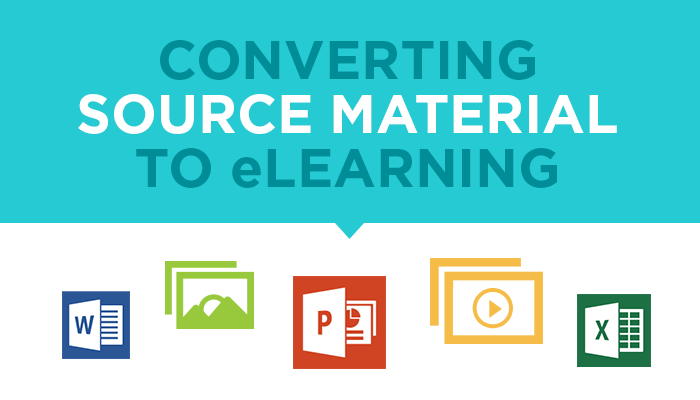This article discusses best practices for organizing your existing source content and preparing it for conversion to interactive e-Learning. Use the list below for ideas about the types of training material you may already have on hand in order to start your e-Learning project off on the right foot.
Source Material Job Aid
Initial Storyboarding/Script Writing
Existing Training Material
Assemble all directly relevant and ancillary material into a one or more compact (e.g., zipped) packages. Organize content into folders and provide file names that are intuitive and make it as easy as possible for all to map the assets to the appropriate lessons/learning objectives.
Quizzes/Exams!
This is listed first because all eLearning should be developed based upon well known and very specific learning outcomes. These outcomes must be measured (generally via some testing instrument), so it is most helpful to know what proficiencies are desired prior to writing supporting content.
Pictures, Graphics, and Charts!
This is listed second to emphasize the point that it is infinitely easier to tell a story based upon a picture or visual idea than it is to write first and then apply images to what is written.
PowerPoint lecture files!
This resource appears in the top 3 because files like these generally convey a sense of established liner progression of concepts and helps SME/Instructional designer to arrange the order in which topics/lessons will be discussed. PowerPoint files also frequently include many graphics/images that will aid the instructional designers.
Training Manuals
Electronic (Word, PDF, etc.) or printed training materials are excellent because they provide existing content that can be easily re-written into eLearning narrative and help the Instructional Designer more quickly understand the subject matter.
Existing Online Training Resources
A collection of URLs / web pages upon which content already exists and that SME and/or Instructional Designer can use for reference
Study Aids
Reference charts, glossaries, etc.
Audio/Video Files
MP3 Audio files, instructional videos, other information that may assist instructional designers/SME understand and integrate concepts as appropriate
Course Description and Syllabus
This info will likely be re-written once the storyboard/scripts have been completed.
Existing Digital Graphics
Find and package up all of the existing digital graphics you have, along with appropriate usage guidelines (Style Guide) and the like.
Official Logo
(along with size/placement instructions).
Royalty-Free images
(licensed or original) photographic and illustrated images. Often times marketing departments will have already acquired various photographic and other art.
Official Style Guide
(corporate colors, fonts, other approved styles). If no official style guide exists, we will build out courseware based on an existing website or other marketing collateral.
Recommendations
Marketing Department
Involve the marketing department early and obtain as many graphic images as you can.
SME to Package Content
Have the SME participate in the organization of assets into logical folders and with appropriate file names. For example, your folder structure for files may model the actual course Table of Contents. Refer to the Table of Contents development worksheet when collecting digital assets.
Company-wide Support
Involve other department heads in the collection of digital assets. Send out an e-mail requesting that all who may know the location of appropriate assets to contact the SME. Often nuggets of great content/assets are hidden away in different departments.
Hand Drawings, etc.
Include scanned versions of hand-written charts, graphics, and other items that may need to be recreated by graphic artists. We can convert your rough-draft ideas into attractive charts/graphs/illustrations, etc.
Clear Instructions
Support the content with a read me file, spreadsheet, or other instructions regarding how you may want certain images treated. For example, make a master list of all images that should be recreated by graphic artists, etc. The more precise your comments, the more the content will reflect your vision.
Read more about Storyboarding or see our Free Storyline Templates on eLearning.net.
Other Recommended Reading:
http://theelearningcoach.com/elearning_design/how-to-organize-content/
